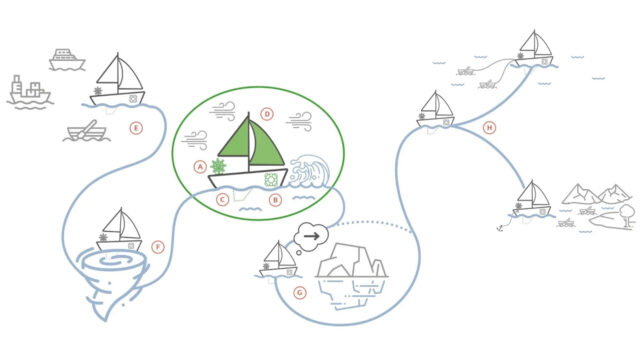Four typical behaviours in interdisciplinary knowledge integration
By Annemarie Horn and Eduardo Urias. Originally published on the Integration and Implementation Insights blog.
Why do some collaborators in interdisciplinary teamwork clash? And why does collaboration between others seem smooth but not yield anything? What causes these differences in collaboration, and how can this inform interventions to support interdisciplinary collaboration and integration?
When we started teaching an interdisciplinary masters course, we expected it to become a battlefield, based on our reading of countless lists of the challenges of interdisciplinary collaboration. We thought that the students’ diverse study backgrounds – ranging from arts to medicine, and from social sciences to mathematics – would cause tensions; that they would disagree with each other about theories and methods that they were unfamiliar with and held opinions about. But, although we observed some heated conversations, the eruption we had anticipated never hit. Instead, the collaboration was surprisingly smooth.
It was exactly this surprise that triggered us to look further. We observed four behaviours among our students that represent four possible ways in which collaborators in a cross-disciplinary team can behave. They all have implications for the integration of knowledge.
Naïve behaviour
 As described, the “naïve” optimism of these students was the initial driver for us to look further. They were excited to engage in interdisciplinary teamwork because they were convinced that, with their knowledge from different fields about different topics, they could make a more meaningful contribution to societal questions. A noble ambition! But also one that arose from a limited understanding of what interdisciplinarity is and takes.
As described, the “naïve” optimism of these students was the initial driver for us to look further. They were excited to engage in interdisciplinary teamwork because they were convinced that, with their knowledge from different fields about different topics, they could make a more meaningful contribution to societal questions. A noble ambition! But also one that arose from a limited understanding of what interdisciplinarity is and takes.
The students assumed that interdisciplinary integration is like a puzzle: each team member brings a few pieces, which seamlessly fit together to form a comprehensive and sensible picture of the whole. These students overlooked the different methods and assumptions that collaborators from different disciplines inevitably bring.
Assertive behaviour
 Assertive behaviour was what we had originally expected to encounter. The students who exhibited this type of behaviour had a strong grounding in their disciplinary field. They mastered key concepts, theories and methods of their discipline, and were confident and motivated to contribute this knowledge to the team effort. They shared their views and knowledge with a certainty that supported decision making and provided direction to the teamwork, but also left little room for revision.
Assertive behaviour was what we had originally expected to encounter. The students who exhibited this type of behaviour had a strong grounding in their disciplinary field. They mastered key concepts, theories and methods of their discipline, and were confident and motivated to contribute this knowledge to the team effort. They shared their views and knowledge with a certainty that supported decision making and provided direction to the teamwork, but also left little room for revision.
They did not ask questions or engage in critical self-reflection to seek out the views of others to enrich, challenge and potentially revise their own ideas. A flip side of their confidence and steadfastness was that they could come across as superior, looking down on other views. We saw this behaviour most commonly among students with a background in the exact or life sciences, and less among students from the social sciences and humanities.
Accommodating behaviour
 Students who exhibited accommodating behaviour asked a lot of questions and actively attempted to make sense of the contributions from others. They were likely to accept the contributions that others made into the teamwork and potentially also into their own understanding of the topic. This made them flexible, and they got a lot of work done for the joint project, bringing the inputs from others together.
Students who exhibited accommodating behaviour asked a lot of questions and actively attempted to make sense of the contributions from others. They were likely to accept the contributions that others made into the teamwork and potentially also into their own understanding of the topic. This made them flexible, and they got a lot of work done for the joint project, bringing the inputs from others together.
However, they did not actively contribute their own views and knowledge to the teamwork. As such, insights from the discipline that they were trained in were under-represented. They were likely to embrace the contributions of others, instead of critically comparing them with the knowledge that they themselves held. Some of these students said that they also felt that their discipline and their knowledge were inferior. We observed accommodating behaviour mostly among students from the social sciences and humanities, and students who had previously received interdisciplinary training.
Integrative behaviour
 Lastly, we observed some rare instances of integrative behaviour among our students. These students engaged in reciprocal interactions, making statements based on their own knowledge and asking questions to grapple with the knowledge of their teammates.
Lastly, we observed some rare instances of integrative behaviour among our students. These students engaged in reciprocal interactions, making statements based on their own knowledge and asking questions to grapple with the knowledge of their teammates.
This dialogue allowed them to build a shared understanding with their collaborators. They were actively connecting their own knowledge with the things that others shared. They questioned whether they understood the things that others said, and compared how these contributions related to their own understanding. As such, we also saw that these students embraced uncertainty and non-knowing as an opportunity to learn and expand their understanding.
Interdisciplinary collaboration and integration
The students with naive behaviour hardly contributed to the integration across the knowledge bases of the collaborators. They did not bring their own (disciplinary) knowledge to the teamwork, and did not engage with the knowledge that others contributed.
The students who exhibited integrative behaviour, at the other extreme, both contributed their own knowledge and engaged with the knowledge of others. This allowed them to actively draw connections between their own and others’ knowledge and thereby engage in knowledge integration.
The students who acted assertively brought their own knowledge, but did not engage with the knowledge from others. Whereas the students with accommodating behaviour did the opposite: they engaged with the knowledge of others, but did not bring their own.
Bidirectional exchange and integration of knowledge thus requires integrative behaviour or a constructive combination of assertive and accommodating behaviours.
Using these insights in practice
Distinguishing among these behaviours has provided us with a way of targeting interventions. We encourage students with:
- assertive behaviour to engage with others’ knowledge by inviting and instructing them to ask each other questions
- accommodating behaviour to contribute their knowledge to teamwork projects, by instructing them to present their work and insights from their field
- naive behaviour to employ a combination of both presentation and engagement.
Do you recognize some, if not all, of these behaviours? Is this a helpful framework for understanding and making sense of these behaviours? Would you find it a useful starting point for intervening in teamwork to support interdisciplinary collaboration and integration?
To find out more:
Horn, A., Urias, E. and Zweekhorst, M. B. M. (2022). Epistemic stability and epistemic adaptability: Interdisciplinary knowledge integration competencies for complex sustainability issues. Sustainability Science. (Online) (DOI): https://doi.org/10.1007/s11625-022-01113-2.
The results are also available in an 8.5 minute video: https://www.youtube.com/watch?v=Y5RXNfIg45Y [also above] and have led to the development of a tool for reflection on interdisciplinary teamwork: https://vu.nl/en/about-vu/more-about/tool-for-reflection-on-interdisciplinary-teamwork-athena-institute.
The illustrations in this blog post are by Annemarie Horn.
Biographies:
 |
1. Annemarie Horn is a PhD student at the Athena Institute, Vrije Universiteit Amsterdam, The Netherlands. Her current research focuses on inter- and transdisciplinarity. In particular, she studies how to support inter- and transdisciplinary learning, by facilitating knowledge integration and training competencies such as epistemological awareness and critical reflection. |
 |
2. Eduardo Urias PhD is an Assistant Professor at the Athena Institute, Vrije Universiteit Amsterdam, The Netherlands. His current research focuses on the institutionalization of participatory and transdisciplinary approaches to research and education; inter- and transdisciplinary collaboration and knowledge integration; and the drivers, dynamics, and implications of small-scale and community-driven initiatives in sustainability transitions. |
Article source: Four typical behaviours in interdisciplinary knowledge integration.





